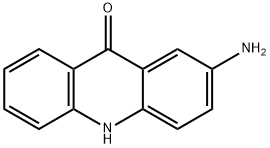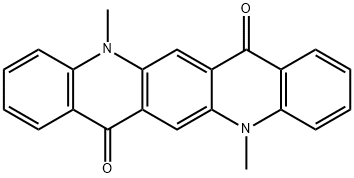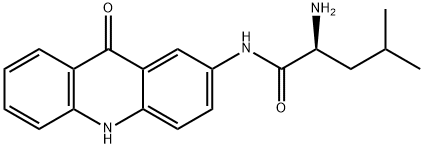2-AMINOACRIDONE
Synonym(s):2-amino-10H-acridin-9-one;2-Amino-9(10H)-acridinone;AMAC;AMAC1L2;Protein AMAC1L2
- CAS NO.:27918-14-5
- Empirical Formula: C13H10N2O
- Molecular Weight: 210.23
- MDL number: MFCD00037397
- EINECS: 634-773-6
- SAFETY DATA SHEET (SDS)
- Update Date: 2025-12-16 21:30:20

What is 2-AMINOACRIDONE?
The Uses of 2-AMINOACRIDONE
2-Aminoacridone is a fluorescent label for glycans and saccharides.
What are the applications of Application
2-Aminoacridone is a highly fluorescent aromatic
Definition
ChEBI: 2-Aminoacridone is a member of acridines. It is functionally related to an acridone.
Synthesis Reference(s)
Journal of Heterocyclic Chemistry, 28, p. 913, 1991 DOI: 10.1002/jhet.5570280413
Properties of 2-AMINOACRIDONE
| Melting point: | 301-303 °C |
| Boiling point: | 442.5±34.0 °C(Predicted) |
| Density | 1.306±0.06 g/cm3(Predicted) |
| storage temp. | Keep in dark place,Inert atmosphere,2-8°C |
| solubility | DMF: soluble |
| pka | 4.00±0.20(Predicted) |
| form | solid |
| color | Green to dark green |
| BRN | 172520 |
Safety information for 2-AMINOACRIDONE
| Signal word | Warning |
| Pictogram(s) |
 Exclamation Mark Irritant GHS07 |
| GHS Hazard Statements |
H315:Skin corrosion/irritation H319:Serious eye damage/eye irritation H335:Specific target organ toxicity, single exposure;Respiratory tract irritation |
| Precautionary Statement Codes |
P302+P352:IF ON SKIN: wash with plenty of soap and water. P305+P351+P338:IF IN EYES: Rinse cautiously with water for several minutes. Remove contact lenses, if present and easy to do. Continuerinsing. |
Computed Descriptors for 2-AMINOACRIDONE
New Products
4,4-Difluoropiperidine hydrochloride tert-butyl 9-methoxy-3-azaspiro[5.5]undecane-3-carboxylate Indole Methyl Resin N-Isopropylurea N,N-Dicyclohexylcarbodiimide(DCC) MELDRUMS ACID 5-METHYLISOXAZOLE-4-CARBOXYLIC ACID Magnessium Bis glycinate Zinc ascorbate 1-bromo-2-butyne 2-acetamidophenol 9(10H)-anthracenone Erythrosin B, 4-Piperidinopiperidine 2-((4-morpholinophenylamino) (methylthio) methylene) malononitrile 2,4-dihydroxybenzaldehyde 3-(4-morpholinophenylamino)-5-amino-1H-pyrazole-4-carbonitrile Methyl 2-methylquinoline-6-carboxylate 2,6-dichloro-4-nitropyridine 4-Bromo-2-chlorobenzonitrile 2-(benzylamino)acetic acid hydrochloride 4-(tert-Butoxycarbonylamino)but- 2-ynoic acid 3,4-dihydro-2H-benzo[b][1,4]dioxepine 1-Phenyl-1-cycloprppanecarboxylicacidRelated products of tetrahydrofuran







![7,16-DIHYDROBENZO[A]BENZO[5,6]QUINO[3,2-I]ACRIDINE-9,18-DIONE](https://img.chemicalbook.in/CAS/GIF/104978-82-7.gif)
You may like
-
 2-Aminoacridone CAS 27918-14-5View Details
2-Aminoacridone CAS 27918-14-5View Details
27918-14-5 -
 3-(4-amino-1-oxoisoindolin-2-yl)-1-methylpiperidine-2,6-dione 98%View Details
3-(4-amino-1-oxoisoindolin-2-yl)-1-methylpiperidine-2,6-dione 98%View Details -
 614-19-7 98%View Details
614-19-7 98%View Details
614-19-7 -
 3112-85-4 Methyl phenyl sulfone 98%View Details
3112-85-4 Methyl phenyl sulfone 98%View Details
3112-85-4 -
 20677-73-0 (2,2-diethoxyethyl)methylamine 98%View Details
20677-73-0 (2,2-diethoxyethyl)methylamine 98%View Details
20677-73-0 -
 3-(4-(hydroxyamino)-1-oxoisoindolin-2-yl)piperidine-2,6-dione 98%View Details
3-(4-(hydroxyamino)-1-oxoisoindolin-2-yl)piperidine-2,6-dione 98%View Details -
 57381-49-4 2-bromo-4-chlorobenzonitrile 98%View Details
57381-49-4 2-bromo-4-chlorobenzonitrile 98%View Details
57381-49-4 -
 4,6-dichloropyrimidine-5-carbaldehyde 98%View Details
4,6-dichloropyrimidine-5-carbaldehyde 98%View Details
5305-40-8
Statement: All products displayed on this website are only used for non medical purposes such as industrial applications or scientific research, and cannot be used for clinical diagnosis or treatment of humans or animals. They are not medicinal or edible.
